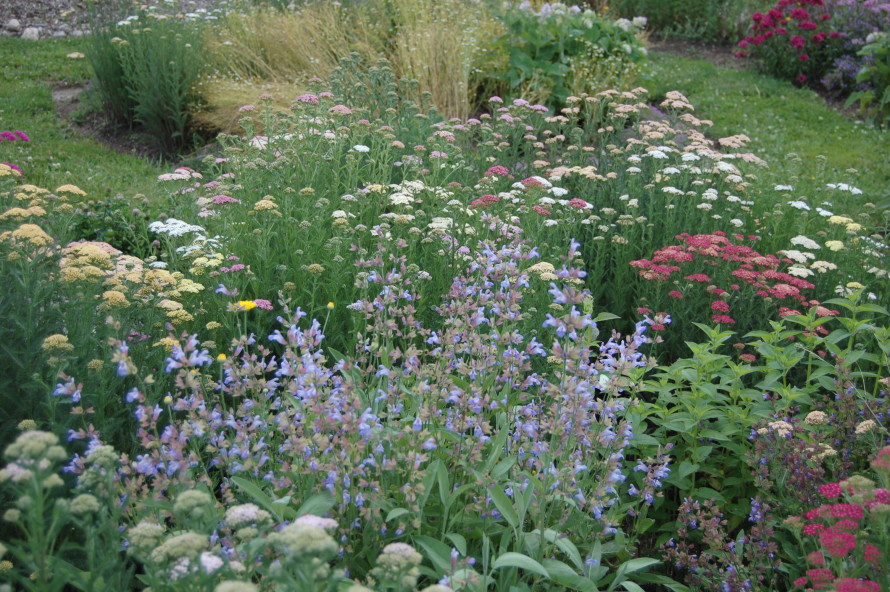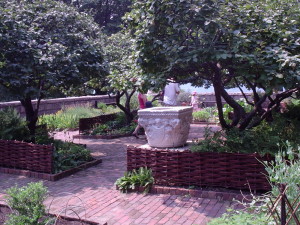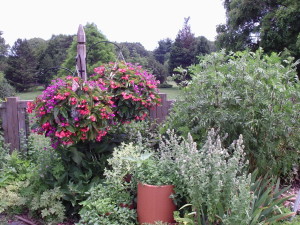The winter months when you can’t garden feel like they last forever. You can put them to good use designing new gardens or redesigning existing gardens. Herbs give you a few choices when it comes to garden design.
You can plant your herbs in your vegetable garden where they will act as companion plants, attract beneficial insects or repel pests. For best results, you should intermingle your herbs with your vegetable plants rather than isolating them in a separate section of your vegetable garden. My favorite way to use my herbs is to plant them with my flowers. Some herbs have gorgeous flowers, like echinacea or foxglove, while others have interesting foliage that add color or texture to my flower beds. If you prefer a separate herb garden, your choices come down to two: a formal herb garden or an informal one.
A formal herb garden, like any formal garden, is symmetrical and is usually designed around a specific feature such as a fountain or a statue. Very often the beds are edged with small boxwood hedges or smaller herbs such as thyme or germander that can be pruned into hedges. Most formal garden plans include paved walkways between the beds. Formal gardens are planted more for looks rather than utility. Plants are carefully placed and maintained. Formal herb gardens are beautiful, but can be high maintenance.
Informal herb gardens can be any size and shape. They are planted more for utility than looks although most gardeners try to make them attractive. The addition of edible flowers such as nasturtiums gives them the air of a pretty cottage garden. Informal herb gardens are lower maintenance.
Conventional wisdom says that beds should be no more than 4 to 5 feet wide. Ignore that. Make your bed as wide as you can comfortably reach to weed, prune and harvest your herbs. If your herb garden is planted along a fence you will only be able to work from one side. Don’t make your bed so wide that you are forced to walk into it to weed or harvest. This will compact the soil making it difficult for your herbs to grow. Or you can add a few stepping stones to allow you to walk into the parts of the garden that you can’t comfortably reach from the sides or front.
Once you have decided on your design, it’s time to decide where to place your herb garden. The most important consideration is sunlight. Most herbs require full sun, meaning 6 to 8 hours of sunlight each day. Choose a sunny spot in your yard for your herb garden. If your yard does not receive full sun, but it does get 3 to 6 hours of sunlight per day (partial shade), there are a few herbs that will tolerate partial shade. Catnip, fennel, lemon balm, mint, parsley, sage, and thyme can all tolerate some shade.
If your herb garden is filled with culinary herbs that you plan to use frequently, you will want to put your garden close to your kitchen. If there is not enough space near that door or you prefer to have your herb garden in another part of your yard, plant a few of your most frequently used herbs near your kitchen either in a small garden or even in containers. Some herbs such as aggressively spreading mints or less hardy herbs such as rosemary (in colder climates) and bay laurel, are grown in containers anyways.
Space is important. Herb plants can get quite large. If your plants are crowded into a tiny space, they will not grow as well, if at all. Make sure that you are allotting enough space for your entire herb garden as well as individual beds within it if you are planning a formal design.
Soil is also an important consideration. Herbs prefer less rich, well-drained soil. If the soil is too rich or you over-fertilize, your plants will get tall and gangly. Besides looking unattractive, too much fertilizer can also affect the taste of your herbs. Herbs grown in rich soil have less taste than herbs grown with less fertilizer.
Good drainage is imperative. If the soil is soggy or holds water, the roots of your herbs will rot. The addition of mulch gives your garden a finished look as well as keeping down weeds and holding moisture in the soil. If you have clay soil, raised beds are a good alternative.
Be sure to plant “like with like”. Plants that like a lot of water such as basil should not be planted near or in the same container as plants like rosemary or lavender that prefer very dry soil. Sun lovers such as chives should not be planted with shade lovers such as ginger. You can intermingle annuals and perennials together as long as they have the same sunlight and water requirements. One herb that you never want to plant with any herb is mint. It spreads aggressively, taking over your entire garden. Keep it confined in containers by itself. The containers can be placed in your herb garden, becoming part of the overall design.
Visit public herb gardens to see plants and get ideas for your own garden. Then choose a sunny spot in your yard and plant your favorite herbs.




3 Comments on “Herb Garden Design”
That lavender ♥ I’m fnlieeg jealous. And yet happy and sad and I really think highly of this shot that touched me in a very good way this morning! I must be too sentimental person crying over a couple of lavenders
Generally, herbal garden designs include an interesting focal point in the center such as a birdbath, fountain, sundial, etc. This also depends on its purpose and your personal taste.
Yes, I did mention that point as reagrds formal herb gardens, however, informal herb gardens don’t include a focal point in the center.